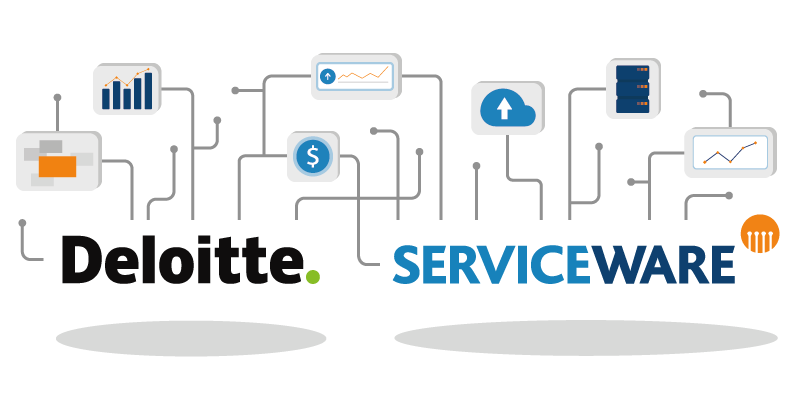In our latest video interview ‘Demonstrating the Value of IT in a Digital Business’, Alex Becker, COO at Serviceware, caught up with Peter Grydgaard, Partner at Deloitte Denmark – a Serviceware business partner, to uncover how CIOs and CFOs can optimize their investments in IT and deliver value back to their businesses.
IT and Finance post-pandemic: transparency is key to making informed IT investment decisions
In 2022, business leaders are focusing their attention on developing the digital side of their organizations to position them for future growth. So much so that 94% of CFOs expect to invest more in digital technology this upcoming year, according to Deloitte reports. Whilst nearly eight in ten businesses surveyed in a Deloitte study had already begun or were considering a tech-enabled transformation.
Peter Grydgaard, who helps clients bridge the gap between Finance and IT, says that post-pandemic, “IT spend is growing and more significant than ever. Clients are required to deliver cost transparency”. However, this transformation has not been easy and many CIOs and their IT teams are struggling with the transition as they contend with a fractious economy that is expected to face an uphill climb on the way to recovery.
In this wayward economy, CIOs, CFOs and IT teams have all been expected to deliver greater value faster within tighter budgets. The pandemic created many unforeseen expenses for businesses, including investments in virtual business operations, which forced them to cut costs elsewhere to improve cash flow.
Grydgaard says, “Everyone was nervous regarding the consequences of COVID and how their businesses would be impacted by it – and there is no simple answer. At the beginning of the pandemic, most companies held back investments in technology. Now, companies are positioning themselves to be ready for new opportunities by investing more in the latest technological capabilities and adopting more flexible ways of working within the organization.”
As some of the effects of the pandemic have taken hold long-term, businesses are focusing their IT spend on areas like cloud adoption, agile workflows, and cybersecurity.
According to Alex Becker, however, for many businesses, “The question is, what is the right investment? If you don’t have the right transparency or the right data it is very tough to make the right decision. In the best case, this only means a slowdown…but in the worst case you make wrong decisions.”
Becker warns that companies are often too short-sighted, only thinking of the initial investment and not factoring in the long-term costs associated with maintenance of the solution. This makes transparency and data integral to getting the investment right.
Sustainability and cloud computing: How can cloud investments support Green IT and why does it matter?
Cloud adoption is a cost-effective and more environmentally friendly option for data management during a time when the c-suite is facing increased pressure to boost sustainability and take climate action. In 2021, some of the biggest banks, including JPMorgan Chase, Citi and Morgan Stanley, committed between $1 trillion and over $2.5 trillion towards climate action and sustainable development.
Following last year’s COP26, it was clear that net-zero pledges have become the business norm, however, businesses are struggling to put action to their pledges. According to McKinsey & Company, using digital to create cost and price transparency can help with sustainability management.
Transparency ensures cloud investments are both sustainable and cost-effective. Becker says, “You need good data on the current total cost of ownership of a service that you want to move to the cloud… It’s important to know how much a service costs you today, as this can help determine whether an investment to the cloud makes sense in the short and long-term.”
According to Grydgaard , “Working towards net-zero and eliminating the emissions from your own IT operations is a significant part of reducing costs. Our research shows that, for many, cloud computing is already a cleaner and welcome improvement. Less hardware running and fewer workloads mean less electricity consumed. However, cloud data centers still need electricity to power them. That’s where greener, sustainable cloud computing comes in, replacing fossil fuel-based grid energy with renewable resources.”
How to demonstrate the value of IT
When companies look to invest in IT Financial Management solutions, they usually want to accomplish three primary objectives: manage source data, cost model it and visualize findings through report generation. However, before integrating solutions, Grygaard says, “The first thing companies need to do is look at their architecture and how it’s supported across the interface”.
From there, companies can invest in individual solutions or partner with an ITFM service provider (such as Serviceware) that offers a portfolio of solutions in one place to meet their needs. A comprehensive ITFM solution can assist businesses with achieving the necessary level of transparency to enable accurate and growth-promoting decision-making.
Becker adds, “A lot of clients have adopted advanced technologies from our portfolio to face the challenge of managing the cost of global shared services, creating the transparency needed to improve decision making”.
Future considerations for IT and Finance: how do businesses adopt a transparency-focused model?
With transparency companies can establish a clear steering model with an accurate understanding of the cost, value and optimization potential, allowing for investment decisions that offer returns for the business.
Grydgaard says, “A more flexible approach to planning and forecasting is, therefore, required. We recommend creating scenarios to prepare for different, maybe even extreme, conditions in your business. If you plan for the future, you might be well advised to think about different options: quick recovery, longer inflation, and recession – who knows. Having the tools in place to easily create and compare such variants makes you much more flexible and adaptable”.
Becker adds , “For me creating the necessary transparency and establishing a database that allows you to flexibly analyze and adapt your cost base is crucial. Therefore, companies should have a clear steering model for their technology costs, which includes processes and governance”.
Business will become increasingly digital, with data sharing across platforms and the use of automation tools to replace time-consuming manual data work and processes. Digital transformation requires strong levels of transparency around investment costs vs ROI. If CIOs and CFOs do not ensure sufficient transparency it is difficult to make informed decisions. Solutions like Serviceware and Deloitte’s joint ITFM and consulting offering unload that burden to ensure the success of digital transformation investments.
“The pandemic accelerated the digitalization process in companies significantly. Now is the right time to set up tools to manage IT investments to ensure they are cost-effective and maximize business value,” concludes Becker.
At Serviceware we recognize that these are challenging times for CIOs and CFOs with many forced to make difficult decisions to ensure their IT investments are cost-effective.


